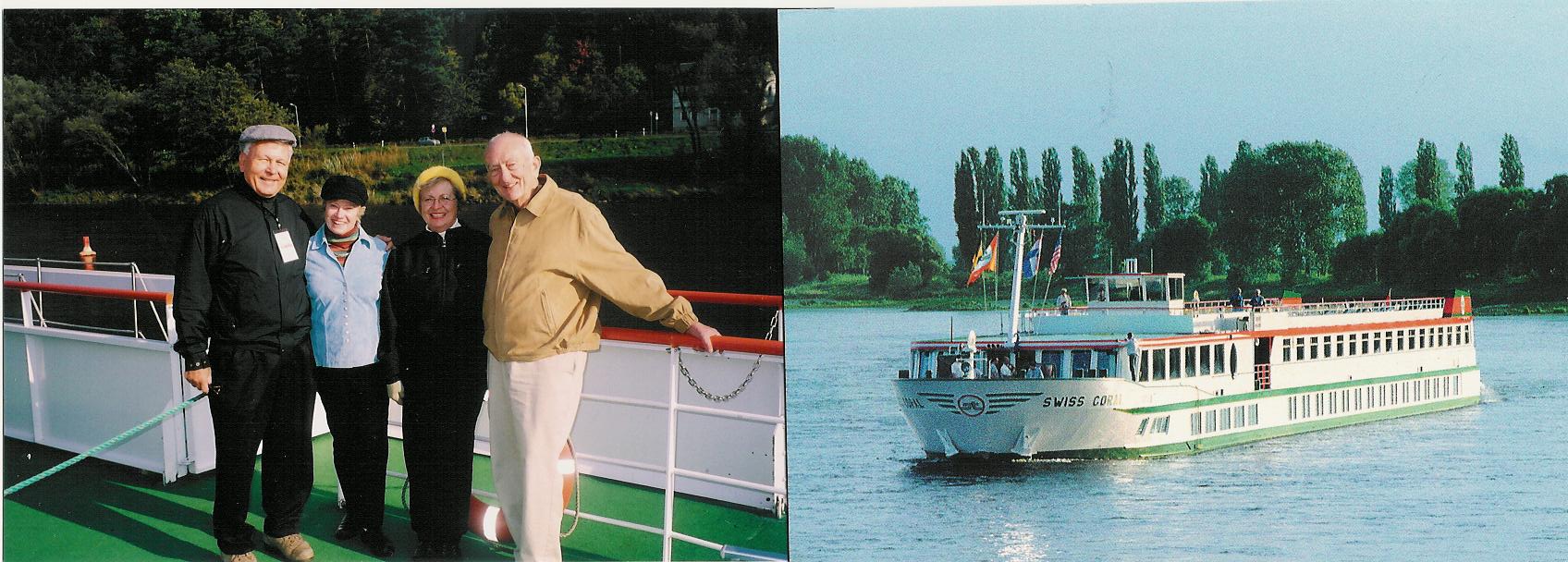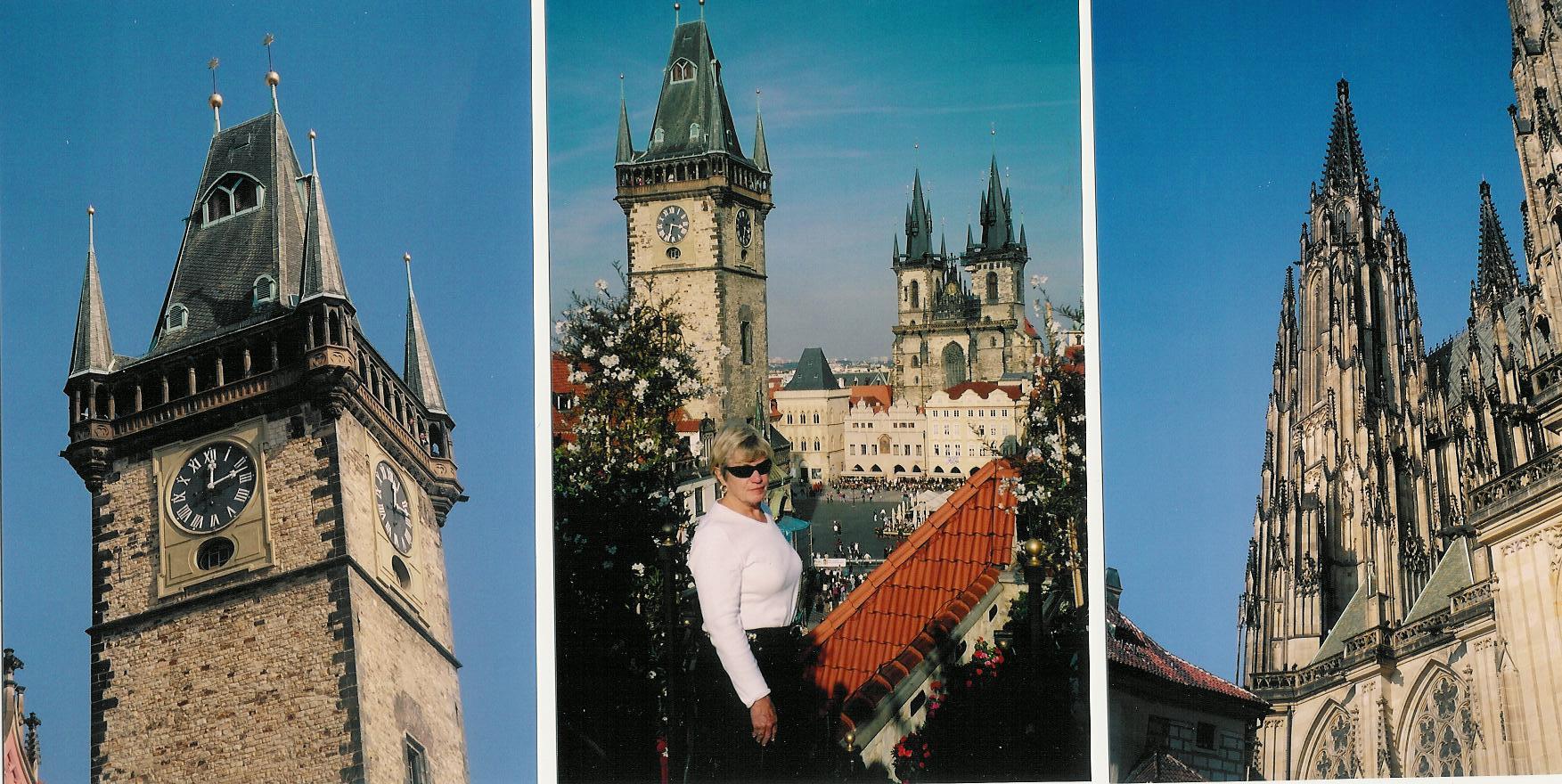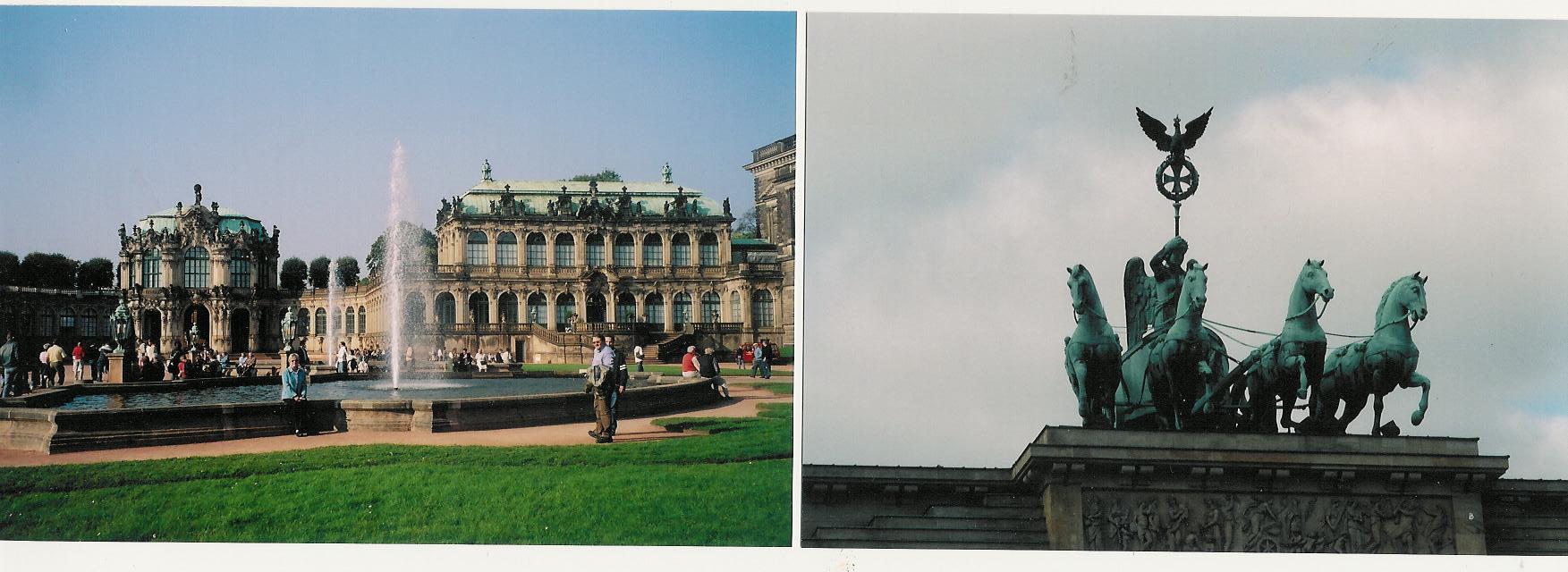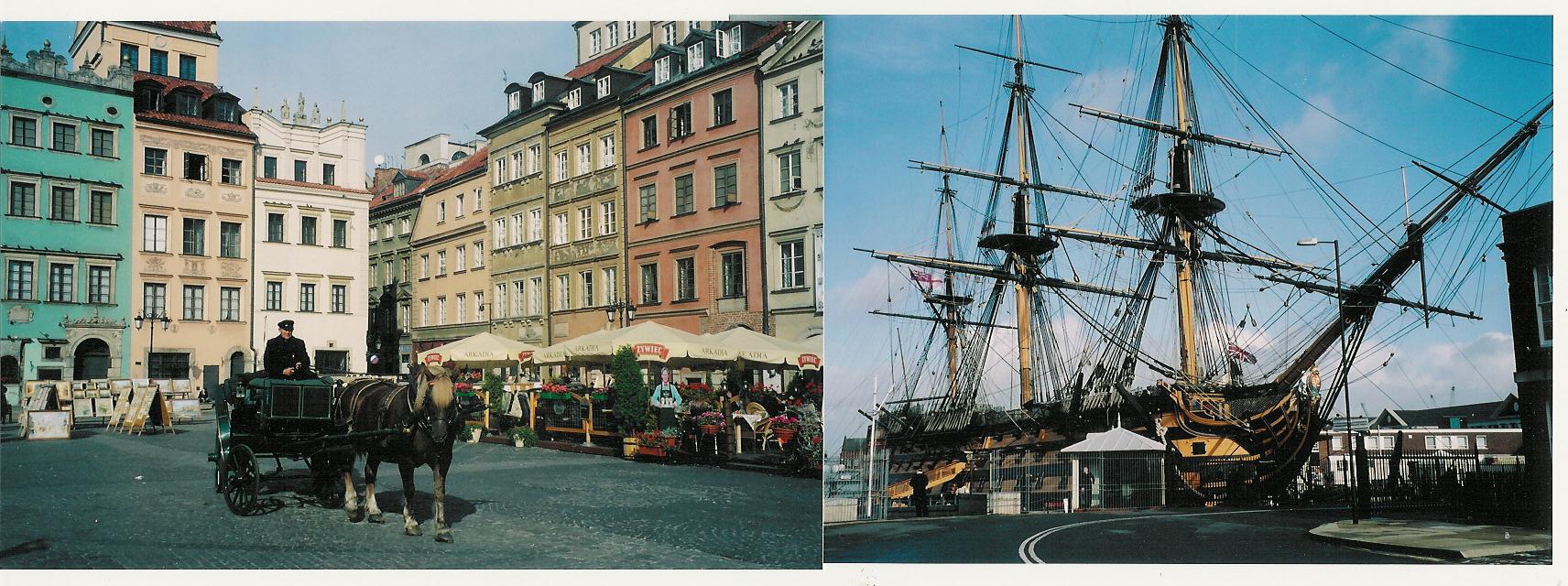
A Cruise down the Elbe
The centerpiece of the trip was an eight day cruise down the Elbe River from Prague to Berlin with stops along the way to visit some of the historic cities of the Saxony region followed by a continuing trip to Warsaw and London at the end of the cruise. Our traveling companions once again were Ron and Gay Baukol.

Cruising down the Elbe
It would not have possible to make this trip even as recently as fifteen years ago. Prague, East Berlin and Warsaw were all behind the Iron Curtain and travel was restricted. The Elbe River itself passed through the Czech Republic, East Germany and West Germany, where the political situation between the countries made river travel all but impossible for both passengers and commerce. That all changed in 1989 with the fall of Communism in Eastern Europe.
The legendary Elbe River has always been an important river in Germany. Located between the Rhine River to its west and the Odor River to its east, the so-called middle river was the cradle of German civilization. The name “Elbe” simply meant “The River”. At the time of Charlemagne, the Elbe formed the eastern border of Germany. Various territorial wars through the years with its Slavic neighbors moved the border eastward into Poland and Russia. More recently, before the fall of Communism in Europe, the Elbe River formed a part of the boundary between East and West Germany.
Prague. The capital of the Czech Republic is known as the city of spires. Dominated by the slim, twin spires of the Gothic St. Vitus Cathedral and the Hradcany Castle set high on one of the seven hills, the skyline in punctuated by a series of spires and domes in every conceivable shape. No one seems to know how many there are; one source will speak of 500, another of 1000. They combine to create one of the most spellbinding views in all of Europe.

The Spires of Prague
We stayed in a small, fifteen room hotel in a 12th century building located on the Old Town Square located in the center of town. From our top floor garret room, we could look out over the twin spire church of St. Tyn and the historic astronomical clock located on the cobblestone square below. We took walking tours which left every morning and afternoon from the square to the Prague Castle, the Jewish Quarter, Wenceslas Square and other places of interest all of which were in easy walking distance from city center. We also attended four different evening concerts by professional ensembles performed in nearby cathedrals and palaces which featured the music of Dvorak, Smetana and other classical Czech and European composers.
On our final day in Prague, we were joined by Ron and Gay Baukol, our erstwhile traveling companions, for an eight day cruise down the Elbe River to Berlin.
Elbe River Cruise. Our eighty passenger cruise ship, the M/S Swiss Coral, was long (300 feet) and narrow (37 feet) with a very shallow draft (4 foot), built specifically to navigate the narrow, winding canals and rivers of Europe. We typically cruised during the night and spent our days visiting the historic cities along the river. In between, we enjoyed sitting up on the deck as ship meandered slowly through the Saxony countryside.
Our stopovers included: Dresden - known as the Florence of the Elbe, because of its many beautiful buildings. Bombed into rubble near the end of the war the city has slowly been restored to its former grandeur; Meissen – renown for the manufacture of fine porcelains, which were developed here in the 18th century; Torgau – a medieval town overlooking the Elbe, where the American and Russian armies connected in April of 1945 cutting Germany in half and signaling the start of the end for Nazi Germany; Wittenberg – the birthplace of the Protestant Reformation, where Martin Luther lived and preached and where he posted his Ninety Five Theses on the door of the castle church; and Potsdam – a suburb of Berlin on the Havel Canal, the former summer home of Frederick the Great and location of the historic meeting of Churchill, Stalin and Truman in 1945 to determine the fate of post-war Germany.
As we traveled along the Elbe, I thought about my German ancestors, who came to America in the 1850’s, wondering what their circumstances may have been and why they might have decided to immigrate to America. We passed less than one hundred miles from the Hopfensack clan’s hometown of Udestedt and I found myself glancing at the locals on the streets of Saxony to see if I could detect any family resemblances. Unfortunately the cruise schedule didn’t allow the time to explore my German roots.

Zwinger Palace - Dresden Brandenburg Gate - Berlin
Berlin. Val and I had visited Berlin in 1973. It was a bitterly divided city then. We visited the Berlin Wall, Checkpoint Charlie and took a bus tour of East Berlin. The contrasts between East and West were stark and dramatic. Today there is very little visible evidence of the divide between West and East Berliners. Some sections of the wall remain as historical landmarks but much of the wall has been broken in to small chunks and sold a souvenirs.
Although Germany has had a long and colorful history dating back to the Teutonic Knights, Charlemagne and the Prussian Empire, we found it hard not to get caught up in their recent history – the rise of Hitler, World War II, the Holocaust, the Iron Curtain, the Berlin Airlift and finally the fall of Communism and the reunification of Germany. Ghosts of all this recent past were all around us as we toured Berlin.
Now thirty years after our initial visit, we were pleased to see that Berlin is re-emerging as one of the great capital cities of Europe once again, with wonderful museums (the Pergamon), elegant shopping streets (the Ku'damm Strasse) and Europe's largest department store (the KaDeWe). It also proved to be an auspicious place to celebrate my 5B birthday with Brats and Beer with the Baukols, followed by a Beethoven symphony performed by the Berlin Symphony Orchestra in the restored and resplendent Berlin Concert Hall near our hotel in the center of the city.
Warsaw. As a tourist destination, Warsaw has long been overshadowed by some of the other post-Soviet East European capital cities like Prague, Berlin and Budapest but this city of two million people is struggling hard to catch up. Totally destroyed by the Germans in World War II, it is working to restore its historic buildings while at the same time constructing new skyscrapers for the future.
Touring the city, it is hard to realize that almost every historic building and monument has been reconstructed in just the past several decades. Bombed into submission at the outbreak of World War II, the city was totally razed on Hitler’s orders following the heroic but futile Warsaw uprisings in 1944. A year earlier, the Jewish ghetto in the center of Warsaw had been totally destroyed in retaliation for the ghetto uprising with virtually all of the 400,000 ghetto residents transported to the extermination camps in nearby Auschwitz and Treblinka. The horrific memories of this terrible tragedy was brought home to us once again as we toured the site of the Ghetto uprising and visited the Jewish memorials in the city.
Following our earlier musical evenings of Dvorak in Prague and Beethoven in Berlin, our musical tour of the eastern European capitals continued with a private Chopin recital on our second evening in Warsaw. The concert took place in a gilded drawing room in the summer palace of the last Polish king and the music, the setting and the wonderful performance combined to make it a memorable evening.
We were treated to a second, equally memorable evening on the final night in Warsaw when Ron was able to arrange an invitation for Val and me to attend a dinner of his Caux Roundtable group at which the guest speaker was Lech Walesa, the leader of the Solidarity Movement, Poland’s first elected president and a Nobel Peace Prize winner. His hair and signature moustache have grayed since the first news photos of him leading the strikes at the Gdansk shipyards in 1980, which led to the eventual fall of Communism in Poland nine years later, but his speech was energetic and inspiring and we were thrilled to see him.

Old Town Square - Warsaw HMS Victory - Portsmouth, England
London. The fourth and final European capital on our itinerary was London, from which we traveled with Cousins John and Anne Underwood down to the south coast to Portsmouth to participate in the 200th anniversary celebration of the Battle of Trafalgar. What better way to commemorate Horatio Nelson’s historic victory over Napoleon’s fleet than by a visit to Nelson’s flagship, the HMS Victory! The massive, oaken vessel, which carried 850 men and 104 cannons, is still a commissioned ship, carried on the active duty roles of the British Navy, and has been maintained in top, shipshape condition. The chance to go on board and tour this great ship, which changed the course of history, was an once-in-a-lifetime thrill for this old sailor. Unfortunately, we just missed dinner with the Queen, who had been on board the Victory for the anniversary celebration the previous day.
We also toured the HMS Warrior, the world’s first iron-clad battleship and had a chance to view the Mary Rose, Henry VIII’s, 16th century flagship. Only recently raised from the bottom of Portsmouth Harbor after its sinking almost 450 years ago, the Mary Rose is on display in a giant museum along with hundreds of amazing artifacts brought up from the bottom.
We capped off this memorable day with a private dinner at the historic HMS Nelson mess with John and Anne, their children and grandchildren. The dinner was arranged by their son-in-law, Lt Cdr. “Beastie” Williams, who is a member of the mess. It was a thrill to dine in the hall where so many famous, British naval officers have dined and great fun to be included as honorary members of the Queen's Navy and the Underwood family for the evening.